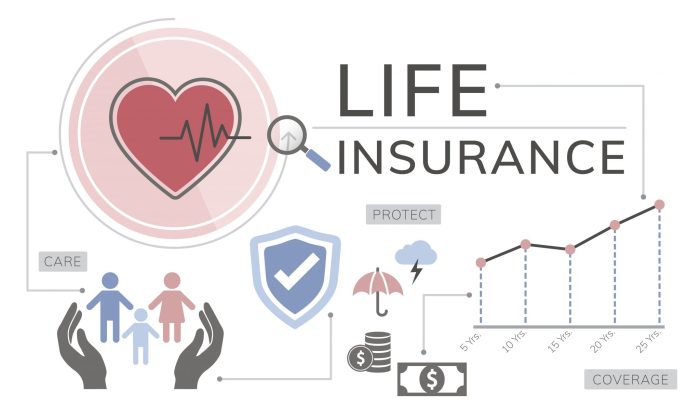Securing your family’s financial future through life insurance is a crucial step in responsible financial planning. However, navigating the complexities of life insurance premiums can feel daunting. This guide demystifies the process, providing a clear understanding of how premiums are calculated, the factors influencing their cost, and the various policy options available. We’ll explore different premium structures, payment methods, and the impact of policy riders, equipping you with the knowledge to make informed decisions about your life insurance coverage.
From understanding the basic principles of premium calculation based on factors like age, health, and lifestyle to exploring the nuances of term life, whole life, and universal life insurance policies, this guide offers a comprehensive overview. We’ll delve into the financial implications of different payment schedules and provide illustrative examples to clarify the often-confusing world of life insurance premiums. By the end, you’ll be better prepared to choose a policy that aligns with your individual needs and budget.
Factors Affecting Premium Costs
Life insurance premiums are carefully calculated based on a variety of factors, ensuring that the cost reflects the individual’s risk profile. Understanding these factors can help you make informed decisions about your coverage and budget. This section details the key elements that influence the price you pay for your life insurance policy.
Health History’s Impact on Premium Rates
Your health history plays a significant role in determining your life insurance premium. Insurers assess your medical records to identify any pre-existing conditions or past illnesses that could increase your risk of death. Conditions like heart disease, diabetes, or cancer can lead to higher premiums, reflecting the increased likelihood of a claim being filed. For instance, an applicant with a history of heart disease might be assigned a higher risk category, resulting in a more expensive premium compared to a healthy applicant of the same age and gender. The severity and frequency of medical issues are also taken into consideration. A single, well-managed instance of a condition may have less impact than a history of multiple serious illnesses.
Lifestyle Choices and Premium Costs
Lifestyle choices significantly influence premium costs. Insurers consider factors like smoking, alcohol consumption, and exercise habits. Individuals who engage in risky behaviors, such as smoking or excessive alcohol use, are considered higher risk and therefore pay higher premiums. Conversely, maintaining a healthy lifestyle through regular exercise and a balanced diet can lead to lower premiums, as it indicates a lower risk profile. For example, a non-smoker who regularly exercises might qualify for lower premiums than a smoker with a sedentary lifestyle. The impact of these lifestyle choices is often assessed through questionnaires and sometimes requires medical examinations.
Occupation’s Role in Determining Premium Amounts
Your occupation also impacts your life insurance premium. High-risk occupations, such as those involving dangerous machinery or hazardous materials, generally result in higher premiums. This is because the insurer recognizes the increased likelihood of death or injury related to the job. For example, a construction worker might pay more than an office worker due to the inherent risks associated with their profession. Similarly, occupations with high stress levels or long working hours may also influence premium calculations.
Smokers versus Non-Smokers: Premium Comparison
Smokers consistently pay significantly higher premiums than non-smokers. This difference reflects the significantly increased risk of death associated with smoking. The higher risk is due to various smoking-related illnesses, such as lung cancer, heart disease, and respiratory problems. The premium difference can be substantial, often doubling or even tripling the cost for smokers compared to non-smokers with similar profiles. Many insurers offer programs to help smokers quit, which can lead to reduced premiums over time.
- Health History: Pre-existing conditions and past illnesses influence risk assessment and premium calculation.
- Lifestyle Choices: Smoking, alcohol consumption, and exercise habits directly impact premium rates.
- Occupation: High-risk professions often lead to higher premiums due to increased risk of injury or death.
- Smokers vs. Non-Smokers: Smokers typically pay considerably higher premiums than non-smokers due to significantly increased health risks.
Types of Life Insurance Policies and their Premiums

Choosing the right life insurance policy involves understanding the different types available and how their premium structures vary. This section details the premium characteristics of several common life insurance options, allowing for a more informed decision-making process.
Term Life Insurance Premiums
Term life insurance provides coverage for a specific period, or “term,” typically ranging from 10 to 30 years. Premiums for term life insurance are generally lower than for permanent life insurance policies because they only cover a defined period. The premium amount is determined by several factors including the applicant’s age, health, the length of the term, and the death benefit amount. Younger, healthier individuals typically qualify for lower premiums. Premiums remain level throughout the policy term, offering predictability in budgeting. Once the term expires, the policyholder can renew it at a higher rate (reflecting increased age and risk) or allow it to lapse. For example, a 30-year-old healthy male might secure a 20-year term life insurance policy with a $500,000 death benefit for a relatively low monthly premium, compared to a similar policy for a 50-year-old.
Whole Life Insurance Premium Payment Options
Whole life insurance provides lifelong coverage and builds cash value that grows tax-deferred. Premium payments for whole life insurance can be structured in several ways. The most common is level premium payments, where the policyholder pays a fixed amount each year throughout their life. This offers financial stability and predictability. Other options include single premium whole life, where the entire premium is paid upfront, and limited-pay whole life, where payments are made over a specific period (e.g., 10 or 20 years), after which the policy remains in force with no further premium payments required. The choice of payment option influences the overall cost; single premium policies typically require a substantial upfront investment, while limited-pay policies involve higher annual payments during the payment period.
Universal Life vs. Variable Life Insurance Premiums and Benefits
Both universal life (UL) and variable life (VL) insurance are permanent policies offering lifelong coverage and a cash value component. However, they differ significantly in how the cash value grows. Universal life insurance offers flexible premiums and death benefits, allowing the policyholder to adjust their payments within certain limits. The cash value grows at a rate determined by the insurance company’s current interest rates. Variable life insurance, on the other hand, allows the policyholder to invest their cash value in various sub-accounts, similar to mutual funds. The cash value growth is directly tied to the performance of the chosen investments, making it potentially more lucrative but also riskier. Premiums for both UL and VL policies can be flexible, but the overall cost can vary considerably depending on the investment performance in the case of VL and interest rates in the case of UL. A well-performing variable life policy could have a higher cash value than a universal life policy, but the opposite is also possible.
Comparison of Life Insurance Policy Types
| Policy Type | Premium Structure | Coverage Period | Cash Value | Risk |
|---|---|---|---|---|
| Term Life | Level premiums for a set term | Specific term (e.g., 10, 20, 30 years) | None | Low |
| Whole Life | Level premiums for life, or single premium, or limited-pay | Lifetime | Yes, grows tax-deferred | Medium |
| Universal Life | Flexible premiums | Lifetime | Yes, growth depends on interest rates | Medium |
Understanding Policy Riders and their Premium Impact

Life insurance policies can be customized with riders, which are additional benefits that enhance the core coverage. These riders offer protection against specific events or circumstances, but they come at an added cost. Understanding how riders affect your premiums is crucial for making informed decisions about your life insurance needs and budget.
Adding riders invariably increases your premium. The extent of the increase depends on several factors, including the type of rider, the amount of coverage selected, your age, health status, and the insurer’s underwriting guidelines. Essentially, you’re paying extra for the added protection and flexibility these riders provide.
Accidental Death Benefit Rider Premiums
An accidental death benefit rider pays out a lump sum in addition to the policy’s death benefit if the insured dies due to an accident. The premium for this rider is generally modest, often representing a small percentage of the base policy premium. For example, a $1 million policy might see its annual premium increase by a few hundred dollars to add a $500,000 accidental death benefit. The exact cost will depend on factors like the amount of additional coverage and the insured’s risk profile.
Critical Illness Rider Premiums
A critical illness rider provides a lump-sum payment if the insured is diagnosed with a specified critical illness, such as cancer, heart attack, or stroke. These riders tend to carry higher premiums than accidental death benefit riders because the likelihood of a critical illness is statistically higher than accidental death. The premium will vary depending on the specific illnesses covered, the payout amount, and the insured’s age and health. A $50,000 critical illness rider might add several hundred dollars annually to a base premium, potentially more depending on the specifics of the rider and the insured’s health.
Waiver of Premium Rider Premiums
A waiver of premium rider waives future premiums if the insured becomes totally disabled. This rider provides financial protection during a time of potential hardship. The premium for this rider is generally moderate, and its cost is often related to the insured’s age and health. A younger, healthier individual will typically pay less for this rider compared to an older individual with pre-existing health conditions.
Impact of Multiple Riders on Premiums
Choosing multiple riders will naturally lead to a larger increase in your overall premium. It’s essential to weigh the benefits of each rider against the added cost to determine the optimal coverage for your individual needs and financial situation. For instance, adding both an accidental death benefit rider and a critical illness rider to a policy will result in a higher premium increase than adding just one of these riders. Careful consideration of the potential scenarios and financial implications is vital.
Example of Rider Selection Impact
Consider a 40-year-old male purchasing a $500,000 term life insurance policy. The base annual premium might be $500. Adding a $250,000 accidental death benefit rider might increase the premium by $50 annually, while a $50,000 critical illness rider might add another $100. Together, these riders would increase the annual premium by $150, bringing the total annual cost to $650. This illustrates how selecting multiple riders can significantly impact the overall cost of the policy.
Wrap-Up

Choosing the right life insurance policy is a significant financial decision. Understanding the intricacies of premiums is paramount to securing adequate coverage without unnecessary expense. This guide has provided a framework for navigating the complexities of life insurance premiums, empowering you to compare policies effectively and make informed choices based on your personal circumstances. Remember to consult with a qualified financial advisor to personalize your life insurance strategy and ensure it aligns with your long-term financial goals.
Helpful Answers
What happens if I miss a premium payment?
Missing a premium payment can result in your policy lapsing, meaning your coverage ends. Most policies offer a grace period, typically 30 days, to make the payment before lapse. Contact your insurer immediately if you anticipate difficulty making a payment to explore options like payment plans or policy loans.
Can I change my premium payment frequency?
Yes, many insurers allow you to change your premium payment frequency (annual, semi-annual, quarterly, monthly). However, changing the frequency may affect the overall cost due to administrative fees or interest charges. Contact your insurer to inquire about available options and any associated costs.
How often are life insurance premiums reviewed?
The frequency of premium reviews depends on the type of policy. Term life insurance premiums are generally fixed for the policy term, while whole life insurance premiums may remain level throughout the policy’s duration or be subject to adjustments based on the insurer’s investment performance (for some types of whole life policies).
What factors influence premium increases?
For policies with adjustable premiums, increases can be influenced by various factors including the insurer’s investment performance (for some whole life policies), changes in mortality rates, and increased claims experience. Your insurer should provide you with information regarding any premium adjustments.